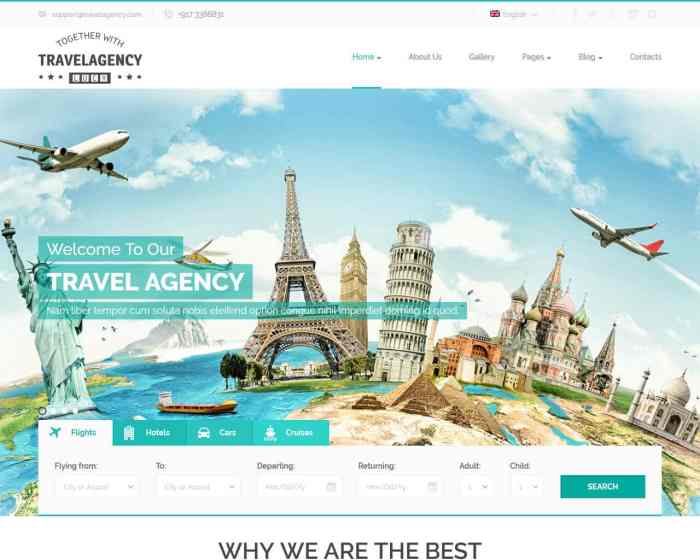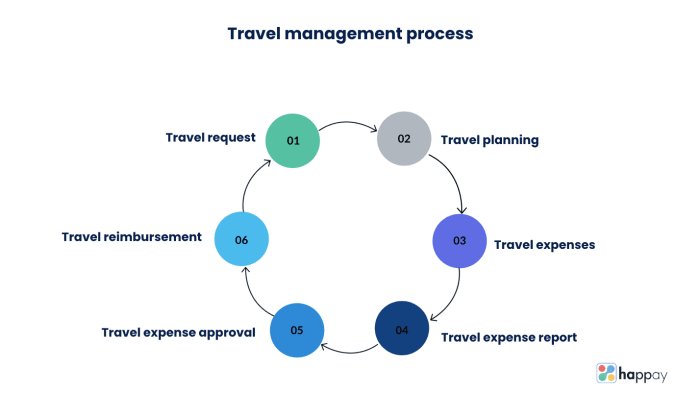Business Travel Booking Sites A Comprehensive Guide
Business travel booking sites are revolutionizing how companies and individuals manage their travel arrangements. From streamlined corporate travel management to convenient individual bookings, these platforms offer a wide array of features and benefits. This guide explores the evolution, functionalities, and key considerations of these services, providing a comprehensive overview for both corporate travel managers and individual employees.
The landscape of business travel booking sites is diverse, encompassing various pricing models, user interfaces, and integration options. Understanding these aspects is crucial for making informed decisions and optimizing travel experiences. This exploration delves into the intricacies of each element, ensuring a thorough understanding of the current state and future trends within the industry.
Introduction to Business Travel Booking Sites

Source: tourandtravelblog.com
Business travel booking sites are online platforms designed to facilitate the planning and management of business trips for individuals and organizations. These platforms streamline the process of booking flights, hotels, and other travel arrangements, often integrating with corporate travel policies and expense reporting systems. They are critical tools for businesses seeking to optimize travel costs, ensure compliance, and improve employee travel experiences.
These platforms offer a wide range of functionalities, including real-time booking capabilities, robust search filters, integrated payment processing, and customizable reporting features. This functionality allows users to efficiently find and book travel arrangements, while often offering insights into pricing and availability, allowing for better cost management.
Definition and Key Features
Business travel booking sites are online platforms that facilitate the booking of travel arrangements for business purposes. Key features include flight and hotel booking, transportation options, visa and passport information, and integration with corporate travel policies. Many platforms offer advanced search filters, customizable reporting, and secure payment processing. The user interface is typically intuitive and easy to navigate, allowing users to quickly find the best options.
Evolution and Historical Context, Business Travel Booking Sites
The evolution of business travel booking sites reflects the broader trend of online service development. Early forms of these services emerged as simple online directories of travel agents and suppliers. Over time, these platforms have become more sophisticated, integrating various travel elements and adding features to enhance user experience. The advent of the internet and advancements in technology have led to significant improvements in speed, accuracy, and convenience. For example, real-time booking capabilities and dynamic pricing models are now commonplace.
Types of Business Travel Booking Sites
Business travel booking sites cater to various needs and organizational structures. This diversity is reflected in the existence of different types of sites.
-
- Corporate Travel Management Platforms:
These platforms are tailored for large organizations and manage travel arrangements for numerous employees. These systems often integrate with internal accounting and expense reporting systems. They frequently feature robust reporting tools to track travel costs, and compliance features to ensure adherence to company policies. For instance, a large corporation might use such a platform to manage travel for thousands of employees across multiple locations.
-
- Individual Booking Platforms:
These platforms offer services to individual business travelers who do not have access to corporate travel management systems. They provide similar functionalities to corporate platforms, but on a smaller scale, and without the integrated policy compliance features. These platforms are commonly used by independent consultants or freelancers.
Comparison of Types
| Feature | Corporate Travel Management | Individual Booking |
|---|---|---|
| Pricing Model | Negotiated contracts, bulk discounts, and potentially tiered pricing based on volume. | Standard pricing models, potentially with some variations in package deals or early booking discounts. |
| User Interface | More complex, often with administrator access for policy management and reporting. | Simpler and more focused on individual bookings. |
| Target Audience | Large corporations and their employees. | Independent business travelers, freelancers, and consultants. |
Key Features and Benefits
Leading business travel booking sites offer a range of features designed to streamline the process for corporations and individual travelers. These platforms provide tools for efficient booking, cost management, and compliance with company policies. The key features vary across different sites, reflecting different approaches to optimizing the travel experience.
Booking sites offer comprehensive solutions, integrating various tools and functionalities to meet diverse corporate travel needs. These tools range from simple booking interfaces to sophisticated analytics dashboards, supporting businesses in managing their travel budgets and optimizing their expenses.
Essential Features of Leading Business Travel Booking Sites

These sites generally offer a centralized platform for booking flights, hotels, and rental cars. Key features frequently include integrated expense reporting, policy enforcement, and real-time tracking of travel arrangements.
- Centralized Booking: This allows for easy management of all travel arrangements in one place. Businesses can monitor and approve travel requests, ensuring adherence to predefined budgets and policies.
- Real-time Tracking: Users can track the status of travel bookings, including flight delays, hotel check-ins, and car rental pick-up times. This facilitates timely responses to potential disruptions.
- Expense Reporting: These platforms often integrate with corporate accounting systems, automatically generating expense reports. This simplifies the process of documenting and submitting travel expenses, saving time and effort.
- Policy Enforcement: Sites often incorporate company travel policies directly into the booking process. This ensures that bookings comply with established standards, including preferred vendors and spending limits.
Benefits for Corporate Travel Managers
These features offer substantial advantages for corporate travel managers, significantly impacting their efficiency and cost-effectiveness.
- Streamlined Management: Centralized booking and tracking systems provide a clear overview of all travel arrangements, enabling managers to easily monitor and control travel spending.
- Cost Optimization: Data-driven insights, often available via the platform’s reporting features, help identify cost-saving opportunities and optimize travel budgets.
- Improved Compliance: Integration with company policies ensures that travel bookings align with predefined standards, minimizing potential compliance issues.
- Enhanced Reporting and Analytics: Automated reporting features enable travel managers to track key metrics, analyze trends, and make informed decisions about future travel strategies.
Benefits for Individual Employees
The benefits extend beyond corporate travel managers to individual employees.
- Simplified Booking Process: Users can easily book flights, hotels, and rentals, saving time and effort. Straightforward booking interfaces reduce the administrative burden on employees.
- Enhanced Travel Experience: Real-time tracking and notifications provide clear visibility into travel plans, ensuring a smoother and more informed travel experience.
- Cost-Effective Bookings: These platforms often leverage competitive pricing and offer discounts on travel services. This can save employees money on their travel expenses.
- Improved Communication: These platforms provide a single point of contact for all travel-related communications, enhancing efficiency and reducing misunderstandings.
Comparative Analysis of Key Features
Different platforms offer varying levels of integration and features. Some focus on specific aspects of travel, such as budget management or specific airline partnerships.
| Feature | Platform A | Platform B | Platform C |
|---|---|---|---|
| Centralized Booking | Yes (comprehensive) | Yes (limited) | Yes (specific airline partners) |
| Real-time Tracking | Yes (detailed) | Yes (basic) | Yes (limited to booked flights) |
| Expense Reporting | Yes (integrated with accounting) | Yes (separate report generation) | Yes (basic expense tracking) |
| Policy Enforcement | Yes (automatic compliance) | Yes (manual enforcement) | Yes (basic policy adherence) |
Pricing Models and Payment Options
Business travel booking platforms employ diverse pricing models to cater to various needs and budgets. Understanding these models and accepted payment methods is crucial for businesses seeking cost-effective and efficient travel arrangements. This section details the common pricing structures, payment options, and factors influencing pricing decisions.
Different platforms utilize varied strategies to determine the final price of a business trip, taking into account factors like the type of travel, the destination, the duration of stay, and the specific requirements. These factors are crucial in shaping the final price. Payment methods and flexibility also play a key role in the overall experience.
Pricing Structures
Various pricing structures are employed by business travel booking platforms. These structures aim to provide flexibility and transparency in the pricing process, aligning with the diverse needs of business travelers.
- Per-diem pricing: This model charges a fixed rate per day for accommodation, meals, and transportation. It’s commonly used for short-term trips with specific requirements for meals and transportation. This method provides a clear and predictable cost structure, making budgeting easier.
- Negotiated pricing: Some platforms allow for negotiated rates, often based on volume or contract agreements. Large corporations frequently utilize this model to secure favorable pricing on multiple trips. Negotiated rates offer considerable cost savings for businesses with substantial travel needs.
- Package pricing: These platforms frequently bundle travel components like flights, accommodation, and ground transportation into packages. This approach simplifies the booking process and can lead to cost savings by combining elements. For example, a package might include round-trip airfare, a hotel stay, and ground transportation.
- Dynamic pricing: This model adjusts prices based on factors such as demand, availability, and time of year. Airlines often use dynamic pricing, where prices increase or decrease depending on the demand and time of booking. Flexibility and real-time adjustments are key features of this approach.
Payment Methods
Business travel booking sites typically support a range of secure payment methods to accommodate various needs and preferences.
- Credit cards: Most platforms accept major credit cards like Visa, Mastercard, and American Express. This widely used method provides convenience and flexibility for travelers.
- Corporate cards: Dedicated corporate payment solutions are often available for companies with established travel policies. These systems offer streamlined invoicing and expense management, which are particularly beneficial for large organizations.
- Direct billing: Certain platforms offer direct billing to the company, streamlining the payment process and reducing administrative overhead. This is frequently employed in large-scale travel arrangements.
- Other payment methods: Some platforms might accept alternative payment methods like e-wallets or mobile payment systems. This approach caters to a wider range of travelers and payment preferences.
Factors Influencing Pricing
Several factors influence pricing decisions on business travel booking sites.
- Destination: Travel costs vary significantly based on the destination. High-demand destinations or those with limited availability tend to have higher prices. For instance, business travel to a popular convention center city will generally cost more than travel to a smaller, less-visited city.
- Time of year: Travel during peak seasons or holidays often results in higher prices. The availability and demand for travel services greatly influence the pricing model.
- Accommodation type: The type of accommodation chosen, whether a luxury hotel or a budget-friendly option, significantly impacts the cost. Businesses will choose accommodations based on their needs and budget.
- Travel duration: The duration of the trip influences the total cost. Longer trips often involve higher costs due to increased accommodation and transportation expenses.
Comparison of Pricing Models
A comparison of pricing models across various platforms reveals differences in approach and flexibility.
| Platform | Pricing Model | Payment Options |
|---|---|---|
| Platform A | Per-diem, negotiated, package | Credit cards, corporate cards, and direct billing |
| Platform B | Dynamic, package, negotiated | Credit cards, corporate cards, e-wallets |
| Platform C | Per-diem, dynamic, negotiated | Credit cards, corporate cards, direct billing, mobile payments |
User Experience and Interface
A seamless and intuitive user interface is paramount for business travel booking sites. A positive user experience (UX) directly impacts user satisfaction and the likelihood of repeat bookings. Effective design principles and clear visual cues are critical for guiding users through the booking process efficiently and minimizing frustration.
The design of a business travel booking site should prioritize clarity, accessibility, and ease of navigation. Users should be able to quickly locate the information they need, complete transactions without undue effort, and find answers to their questions easily. Well-structured interfaces and intuitive navigation significantly enhance the overall user experience.
Design Principles for User-Friendly Interfaces
User-friendly interfaces follow established design principles. These principles ensure that the site is both visually appealing and functionally effective. Visual hierarchy, clear labeling, and consistent design elements are essential for a positive user experience. A well-organized structure ensures that users can easily find the information they need.
User Interface Considerations
Several crucial considerations influence the design of business travel booking sites. These include the ability to filter and sort options, the provision of real-time updates, and the use of visual aids such as maps and charts. A streamlined booking process is paramount, minimizing steps and offering multiple payment options. Furthermore, security features are crucial for building user trust.
Examples of User-Friendly Interfaces
Several business travel booking sites demonstrate exemplary user interfaces. Sites that employ intuitive navigation, clear visual cues, and streamlined booking processes often receive high user ratings. For instance, sites with interactive maps for destination searches and dynamic pricing displays, along with options for comparing different travel packages, are well-regarded. Furthermore, user-friendly filters for various preferences, such as budget, accommodation type, or flight duration, significantly enhance the user experience.
Comparison of Different Booking Sites
Comparing different booking sites reveals diverse approaches to user interface design. Some sites excel in simplicity, focusing on a clean layout and straightforward navigation. Others prioritize customization and flexibility, allowing users to tailor their travel arrangements. Certain sites emphasize visual appeal, while others focus on comprehensive information presentation. Evaluating the strengths and weaknesses of each site’s interface helps understand the spectrum of design choices in this domain.
Table: Key Elements of User Interfaces
| Key Element | Functionality | Impact on User Experience |
|---|---|---|
| Clear Navigation | Easy access to different booking options, destinations, and features. | Reduces frustration and increases efficiency in the booking process. |
| Interactive Maps | Visual representation of destinations and accommodations. | Facilitates location-based searches and comparisons, enhancing the booking process. |
| Real-time Updates | Displays up-to-date pricing, availability, and flight schedules. | Provides transparency and flexibility, allowing users to adapt to changing conditions. |
| Intuitive Filtering | Allows users to tailor searches based on specific criteria. | Enhances efficiency and relevance in locating desired travel options. |
| Secure Payment Options | Offers various secure payment methods. | Builds trust and encourages users to complete transactions confidently. |
Integration with Other Systems

Source: templatemag.com
Business travel booking platforms are increasingly vital for streamlined operations. A key aspect of their effectiveness lies in their ability to integrate with existing business systems, automating tasks, and providing a unified view of travel data. This integration fosters efficiency and reduces manual effort.
Integrating travel booking with other systems like expense reporting and CRM platforms offers significant advantages. Data consistency and reduced errors are paramount, as are the time savings from automated processes.
Integration Methods and Functionalities
Effective integration of business travel booking platforms with existing systems often involves several methods, each offering unique functionalities. APIs (Application Programming Interfaces) are a common approach, allowing seamless data exchange between systems. Web services and middleware solutions are other frequently used methods, enabling data synchronization and workflow automation.
Types of Integrations and Their Functionality
Various types of integrations are available, each designed for specific functionalities. Expense reporting integration allows for automatic expense claims generation, eliminating manual data entry. CRM integration provides real-time visibility into employee travel itineraries, enabling better project management and customer relationship management.
- Expense Reporting Integration: This integration automatically populates expense reports with travel details, eliminating manual data entry and ensuring accurate expense tracking. This reduces errors, saves time, and improves the accuracy of financial records. Travel booking systems often provide detailed reports on flights, hotels, and other expenses, which can then be directly imported into expense management software, thus automating the entire process.
- CRM Integration: This integration facilitates better customer relationship management. Travel booking platforms can sync with CRM systems, providing real-time updates on employee travel itineraries. This enables sales teams to schedule meetings efficiently, plan client visits with ease, and ultimately enhance client relations.
- Booking Calendar Integration: This allows for seamless integration with company calendars, enabling scheduling of travel plans, reducing conflicts, and facilitating team coordination. This is especially valuable for companies with multiple locations and employees.
Examples of Successful Integrations
Numerous businesses have successfully integrated their travel booking systems with other software. For instance, a company using a popular travel booking site might have integrated it with their expense reporting tool, enabling automated expense claims and reducing manual data entry. Similarly, integration with a CRM system could provide sales representatives with real-time access to their team’s travel schedules, enhancing their ability to schedule meetings and maintain client relationships.
Integration Options and Benefits
| Integration Type | Description | Benefits |
|---|---|---|
| Expense Reporting | Automatic expense claim generation from travel booking data | Reduced manual data entry, improved accuracy, and time savings |
| CRM | Real-time synchronization of employee travel itineraries with CRM data | Improved project management, enhanced client relationship management, and increased sales efficiency |
| Booking Calendar | Seamless integration with company calendars for travel scheduling | Reduced scheduling conflicts, improved team coordination, enhanced travel planning |
Security and Privacy Considerations

Source: travelperk.com
Booking business travel involves sensitive data, necessitating robust security measures. Trust and confidence in the platform are paramount for user adoption and sustained use. Comprehensive security protocols and transparent privacy policies are crucial for maintaining user trust and compliance with regulations.
Protecting user data and ensuring secure transactions are essential for maintaining a positive user experience and brand reputation. This section delves into the security measures employed by business travel booking platforms, their privacy policies, and the importance of secure transactions.
Security Measures Employed
Business travel booking platforms employ a multi-layered approach to safeguard user data. This includes encryption of data in transit and at rest, using industry-standard encryption protocols such as TLS/SSL. Access controls and authentication mechanisms are implemented to limit access to sensitive information.
Privacy Policies and Data Protection
Comprehensive privacy policies: Article on how user data is collected, used, and protected. These policies often comply with relevant data protection regulations, such as GDPR (General Data Protection Regulation) or CCPA (California Consumer Privacy Act). Transparency regarding data retention periods and data sharing practices is critical for building user trust.
Secure Transactions and Data Handling
Secure transaction processing is vital. Platforms typically utilize secure payment gateways that encrypt financial information during transactions. Data handling protocols include regular security audits and penetration testing to identify vulnerabilities. Data backups and disaster recovery plans are also essential elements in safeguarding user data.
Best Practices for Data Security
Best practices for data security in this context include:
- Employing strong, unique passwords and multi-factor authentication (MFA) for account access.
- Regularly updating software and security patches to address known vulnerabilities.
- Implementing strict access controls to limit data access to authorized personnel only.
- Monitoring for suspicious activity and promptly responding to security incidents.
Comparison of Security Protocols and Privacy Policies
The following table summarizes security protocols and privacy policies across different business travel booking platforms. Note that specific details may vary depending on the platform and its services.
| Platform | Encryption Protocols | Data Retention Policy | Data Sharing Practices | Compliance with Regulations |
|---|---|---|---|---|
| Platform A | TLS/SSL, AES-256 | Data retained for 5 years | Shared with travel partners for service delivery | GDPR, CCPA |
| Platform B | TLS/SSL, AES-128 | Data retained for 3 years | Shared with travel suppliers for service delivery | GDPR, CCPA |
| Platform C | TLS/SSL, AES-256 | Data is retained indefinitely for compliance purposes | Shared with trusted partners for service improvement | GDPR, CCPA |
Emerging Trends and Future Developments
The business travel booking landscape is rapidly evolving, driven by technological advancements and shifting business needs. Innovative solutions are emerging, promising to streamline the process and enhance the traveler experience. This section explores these emerging trends and forecasts potential future developments in business travel booking sites.
The future of business travel booking is poised for significant transformation, driven by the convergence of technology, changing travel preferences, and evolving business strategies. These advancements are not merely incremental improvements but represent a fundamental shift in how businesses manage and optimize their travel programs.
Emerging Trends Affecting the Industry

Several key trends are reshaping the business travel booking industry. These include a growing emphasis on sustainability, personalized travel experiences, and the integration of artificial intelligence (AI). The increasing adoption of mobile technologies and the rise of cloud-based platforms are also driving substantial change.
- Sustainability Initiatives: Companies are increasingly prioritizing environmentally conscious travel choices. Booking platforms are integrating tools to allow travelers to select eco-friendly options, such as carbon offsetting and reduced-emission flights. Examples include displaying estimated carbon footprints alongside flight options, providing filters for sustainable hotels, and partnering with eco-conscious travel providers.
- AI-Powered Personalization: AI algorithms are being used to personalize the travel booking experience. These systems can analyze traveler data to recommend optimal destinations, hotels, and flights based on individual preferences and past travel history. For example, an AI system might suggest a hotel with a specific type of room or restaurant based on a traveler’s prior bookings or preferences.
- Increased Mobile Adoption: Business travelers are increasingly relying on mobile devices for booking and managing their trips. Booking platforms are focusing on developing user-friendly mobile applications to facilitate seamless transactions and provide real-time updates.
Technological Advancements
Advancements in technology are enabling greater efficiency and personalization in business travel booking. The use of blockchain, augmented reality (AR), and virtual reality (VR) technologies is transforming the way businesses and travelers interact with booking platforms.
- Blockchain Technology: Blockchain’s potential for secure and transparent transactions is being explored for business travel bookings. This technology could enhance security, reduce fraud, and streamline the entire booking process, from payment to confirmation.
- Augmented Reality (AR): AR applications are being developed to provide immersive experiences for travelers. These applications could allow travelers to virtually explore potential destinations or hotels before making a booking.
- Virtual Reality (VR): VR technology can be used to create immersive training experiences for employees or allow travelers to explore a destination virtually before visiting.
Forecasted Evolution of Business Travel Booking Sites (Next 5 Years)
| Year | Key Trend | Impact on Booking Sites | Examples |
|---|---|---|---|
| 2024 | Increased personalization | AI-driven recommendations and dynamic pricing | Personalized itineraries, customized flight/hotel options |
| 2025 | Sustainability integration | Carbon footprint calculators, eco-friendly filters | Carbon offsetting options, sustainable hotel listings |
| 2026 | Enhanced mobile experience | Seamless mobile booking and management | Real-time trip updates, mobile check-in |
| 2027 | Blockchain integration | Enhanced security and transparency | Secure payment processing, verifiable travel documents |
| 2028 | AR/VR integration | Virtual destination exploration, immersive experiences | Virtual hotel tours, interactive travel guides |
Customer Support and Feedback Mechanisms
A crucial aspect of any successful business travel booking site is providing exceptional customer support. Effective support minimizes frustration, resolves issues promptly, and fosters customer loyalty. A robust feedback mechanism is equally vital, enabling the company to identify areas for improvement and tailor services to better meet user needs.
Customer support strategies, channels, and feedback mechanisms directly impact the user experience and ultimately, the site’s success. Booking sites that prioritize these elements tend to attract and retain more customers.
Customer Support Methods
Business travel booking sites employ various methods to address customer inquiries and concerns. These include live chat, email, phone support, and self-service portals with FAQs and knowledge bases. The choice of method often depends on the nature of the inquiry and the site’s resources. For example, simple questions about booking policies might be best handled through a self-service portal, while complex issues or urgent requests often necessitate direct interaction with a support agent.
Feedback Collection Channels
Customer feedback is gathered through diverse channels, enabling the company to understand user preferences and identify areas for enhancement. These channels include in-app surveys, post-booking questionnaires, online review platforms, social media monitoring, and dedicated feedback forms on the website. Prompt and consistent feedback collection is vital to understanding the customer journey and adjusting the booking experience accordingly. For instance, a post-booking survey can solicit opinions on the booking process, service quality, and overall satisfaction.
Addressing Concerns and Complaints
A well-defined procedure for addressing customer concerns and complaints is critical. This includes acknowledging receipt of the concern, promptly investigating the issue, and providing a resolution that satisfies the customer. Booking sites often have a tiered support system, escalating complex issues to senior support representatives or dedicated complaint resolution teams. For example, a complaint regarding a delayed flight or an incorrect booking could be resolved by refunding the ticket or rebooking the flight.
Effective Customer Support Strategies
Effective customer support strategies prioritize proactive engagement and personalized service. This involves anticipating potential issues and providing readily accessible resources, such as comprehensive FAQs and helpful guides. Prompt and courteous responses, along with clear and concise communication, are essential components of a successful support strategy. Furthermore, acknowledging and thanking customers for their feedback, even if it is negative, shows that their input is valued. For example, a booking site might proactively inform customers of potential flight delays and offer alternative solutions.
Example of Support Channels and Feedback Mechanisms
| Customer Support Channel | Feedback Mechanism |
|---|---|
| Live Chat | In-app surveys, post-booking questionnaires |
| Email Support | Online review platforms, social media monitoring |
| Phone Support | Dedicated feedback forms, email feedback |
| Self-Service Portal | In-app feedback widgets, suggestion boxes |
Case Studies of Successful Business Travel Booking Sites
Modern business travel booking platforms have evolved significantly, driven by technological advancements and evolving traveler needs. Understanding the success stories of prominent players offers valuable insights into the key strategies and factors that contribute to a thriving platform. Examining these case studies illuminates the path to building a robust and user-friendly travel booking experience.
Examining successful business travel booking platforms reveals common themes. These platforms have leveraged technology, streamlined processes, and prioritized user experience to become industry leaders. They’ve also effectively integrated with other systems, providing a comprehensive and seamless travel management solution. The analysis of successful implementations highlights the importance of customer-centricity and continuous improvement.
Examples of Successful Business Travel Booking Site Implementations
Several platforms have established themselves as industry leaders through innovative approaches and user-centric design. These include platforms that focus on cost-effectiveness, simplified booking processes, and comprehensive reporting features.
- Concur Travel: A widely recognized platform, Concur Travel emphasizes robust expense reporting capabilities, integrated travel booking, and strong enterprise-level features. Its comprehensive reporting tools empower companies to track and manage travel expenses efficiently. The platform’s focus on automation and streamlined processes contributes to its success.
- Sabre: Sabre is a global travel technology provider. Its platform encompasses a broad range of travel services, including booking, inventory management, and distribution. Sabre’s integration capabilities and wide reach have allowed it to cater to a vast network of travel agents and corporations. This network effect plays a significant role in the platform’s growth.
- Travelport: Travelport offers a vast global network and comprehensive travel management solutions. Its extensive partnerships with airlines, hotels, and other travel providers give it a substantial reach, allowing it to cater to a global customer base. The platform’s strong presence in the global market contributes to its success.
Key Factors and Strategies of Successful Case Studies
These successful platforms have consistently prioritized specific strategies and factors. These include robust technology, user-friendly interfaces, and strong integrations. They’ve also focused on offering competitive pricing and comprehensive customer support.
| Case Study | Key Factors | Strategies |
|---|---|---|
| Concur Travel | Robust expense reporting, integrated travel booking, and enterprise-level features | Automation, streamlined processes, and a focus on cost-effectiveness |
| Sabre | Global reach, comprehensive travel services, strong integrations | Extensive network, partnerships with travel providers, industry-leading technology |
| Travelport | Global network, comprehensive travel management solutions, wide range of travel products | Extensive partnerships, global presence, and catering to a global customer base |
Final Review: Business Travel Booking Sites
In conclusion, business travel booking sites have become indispensable tools for managing and optimizing corporate travel. Their diverse functionalities, encompassing features like seamless integrations, user-friendly interfaces, and robust security measures, cater to both corporate travel managers and individual employees. The future of these platforms appears promising, with continued advancements in technology and evolving customer needs driving innovation in the industry.





